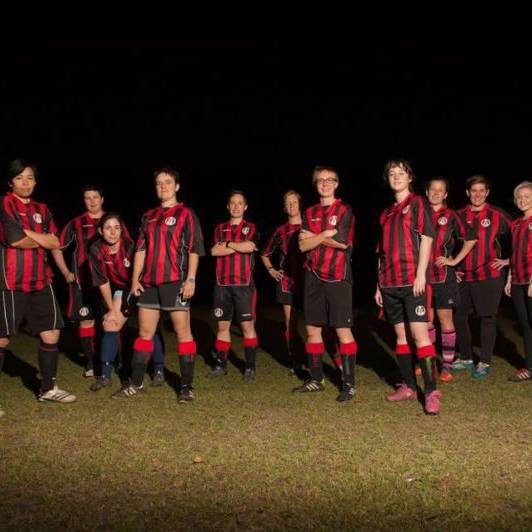 Looking back at the history of women’s soccer.
Looking back at the history of women’s soccer.
When I was a youngster I was good at two things; performing arts and football. I remember my dad being concerned at my obsession with both. The first was a notoriously difficult career option and the latter was no career at all for a woman. Despite the obvious difficulties with either passion ever becoming anything other than a hobby, my parents supported me.
I recall having three orange road cones laid out on our driveway so I could dribble a football up and down the driveway, shooting at the imaginary goals on ours and our neighbour’s walls.
It’s a shame there were no professional options for girls in football back then. I had a fantasy I was good enough. I wasn’t at all. But still, who really knows? It wasn’t an option. I was often told to stop playing football when I joined in with the boys at break times at my infant school. I ignored the request and eventually the teachers stopped saying anything. By the time I went to St Joseph’s College at the age of 13 (an all-girls Catholic school) football wasn’t an option in school. It was netball or hockey or rounders. The “girls’ sports”.
A hundred years ago women’s football was regularly drawing in crowds of tens of thousands of people.
Women had always played football but it became huge during the first world war when women took up traditionally “male” jobs whilst the men were away fighting. One of these traditionally masculine jobs was a munitions worker. Factories sprung up all over the place. Informal kick-abouts became a favourite pastime for groups of female workers in their break-times. As the war progressed, football became formalised for women and teams sprung up at munitions factories all over the country. It was actively promoted for health, wellbeing and morale.
The Munitionette’s Cup was established in August 1917 and it drew in huge crowds to the games which were played in official FA club grounds. The biggest of these took place on Boxing Day in 1920. Everton’s Goodison Park ground packed in 53,000 people, with thousands more trying to get in to see the star team of the time (Dick, Kerr’s Ladies FC from Preston) beat St Helens 4-0.
The war ended. The factories rapidly closed and women who had been liberated and galvanised during this period were expected to step back into their domestic lives; their “right and proper” place in society. Football was no longer seen as offering a health benefit. Now top physicians such as Dr Mary Scharlieb of Harley Street deemed it a “most unsuitable game, too much for a woman’s physical frame”.
On 5 December 1921 the FA announced they were banning all women’s matches from FA-run grounds, ultimately removing the opportunity for women to play in front of huge crowds. They stated: “Complaints having been made as to football being played by women, the council feel impelled to express their strong opinion that the game of football is quite unsuitable for females and ought not to be encouraged.”
Women’s matches had been played for charitable causes.
The Dick, Kerr’s Ladies alone raised £17,000 (about £14 million in today’s money), for ex-servicemen, hospitals and needy children. In 2005 Alice Barlow, who had played for that team, told the BBC in reference to the 1921 FA ban, “It came as a shock… and we could only put it down to jealousy. We were more popular than the men and our bigger gates were for charity.”
Whatever the reason behind the ban, it changed the face of the women’s game forever, pushing it back to only ever being a hobby for the women who played it. To this day, the ban has an impact on the way women in football are seen. You only have to be unfortunate enough to come across vile, sexist threads about respected female commentators on the likes of Twitter. Or listen to the sexism aimed at female assistant referees whilst trying to enjoy watching a match in the pub. The boring, oh so boring, jokes about women not understanding the off-side rule. Yawn. Enough already.
In July 1971 the ban was finally lifted following the formation of the Women’s Football Association (WFA) a couple of years earlier.
The Sex Discrimination Act of 1975 made it easier for women to train and became professional referees. Legislation is one thing but changing deep-rooted discrimination is a whole other… ball game. It was Italy, in 1985, which became the first country with semi-professional women players, and in 1989 Japan became the first country to launch a semi-professional women’s football league, the L League, still in existence today. We were seriously slow in England.
But in 2011 the FA introduced the Women’s Super League. It managed to sell the commercial rights separately from the men’s game; its broadcast rights and sponsors. This meant that the investors involved wouldn’t sit back but would actively help to grow the game. As a result of the Women’s Super League, all the players are now full-time professionals. This has raised the standard of the game further as players are finally able to train all day, every day. BT Sport has bought the rights for the WSL live games and highlights, and the BBC has the rights for all international matches. Things are really on the up.
I’ve always enjoyed watching football. I loved playing it. In my opinion, women’s football takes on a huge team element with little individual ego. My friend Kelly Simmons is director of development at the FA. She took me to the first International Women’s friendly played at the new Wembley stadium on 23 November 2014. It was England v Germany. England lost 3-0, but what a fantastic day out. The thing that struck me most about it was the number of families there; parents, grandparents and kids all enjoying the game together. The German and English fans were interspersed. Maybe a conscious decision to change the feel of the women’s game from the men’s game, from a supporters point of view? I’m not sure. It felt really good, though; fun and safe. The women had drawn a bigger crowd than the men’s previous friendly with 55,000 tickets sold.
Times are changing.
And it’s exciting. The success of our women in all sports at the last two Olympics has definitely helped women in sport in this country. At one point only women’s tennis was taken seriously enough to be televised regularly and make full-time professionals out of its top athletes. Even though I never had any chance of ever making a career out of football (not much to do with my lack of opportunity; I really wasn’t good enough), football did change the path of my life. I met my wife Ellie on the pitch. I was left forward and she was left back. We’ve always made a great team.
This year we can support our England and Scotland Women’s teams in the Euros in July/August. Kelly tells me England is entering the competition as one of the favourites to take the title. She’d know. Hopefully we’ll finally have something to cheer about again in football. And it won’t be the blokes.



